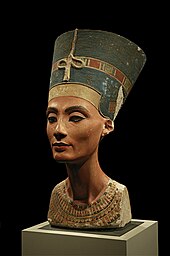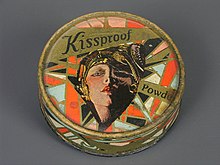In the U.S., the Food and Drug Administration (FDA), which regulates cosmetics,[2] defines cosmetics as "intended to be applied to the human body for cleansing, beautifying, promoting attractiveness, or altering the appearance without affecting the body's structure or functions." This broad definition also includes any material intended for use as a component of a cosmetic product. The FDA specifically excludes soap from this category.[3]
Contents
History

Nefertiti bust showing the use of eye liner

An 1889 Henri de Toulouse-Lautrec painting of a woman applying facial cosmetics

Kissproof brand face powder from 1926, from the permanent collection of the Museo del Objeto del Objeto in Mexico City.
Main article: History of cosmetics
The word cosmetics derives from the Greek κοσμητικὴ τέχνη (kosmetikē tekhnē), meaning "technique of dress and ornament", from κοσμητικός (kosmētikos), "skilled in ordering or arranging"[4] and that from κόσμος (kosmos), meaning amongst others "order" and "ornament".[5] The first archeological evidence of cosmetics comes from the hollowed out tombs of the Ancient Egyptian pharaohs.[6] Archaeological evidence of cosmetics dates at least from ancient Egypt and Greece. According to one source, early major developments include:[1]- Castor oil used by ancient Egypt as a protective balm.
- Skin creams made of beeswax, olive oil, and rosewater, described by Romans.
- Vaseline and lanolin in the nineteenth century.
- Nivea in 1911.
One of the most popular Traditional Chinese Medicines is the fungus Tremella fuciformis; used as a beauty product by women in China and Japan. The fungus reportedly increases moisture retention in the skin and prevents senile degradation of micro-blood vessels in the skin, reducing wrinkles and smoothing fine lines. Other anti-ageing effects come from increasing the presence of superoxide dismutase in the brain and liver; it is an enzyme that acts as a potent antioxidant throughout the body, particularly in the skin.[9]
Cosmetic use was frowned upon at many points in Western history. For example, in the 19th century, Queen Victoria publicly declared makeup improper, vulgar, and acceptable only for use by actors.[10]
During the sixteenth century, the personal attributes of the women who used make-up created a demand for the product among the upper class.[11]
Of the major cosmetics firms, the largest is L'Oréal, which was founded by Eugene Schueller in 1909 as the French Harmless Hair Colouring Company (now owned by Liliane Bettencourt 26% and Nestlé 28%; the remaining 46% is traded publicly). The market was developed in the USA during the 1910s by Elizabeth Arden, Helena Rubinstein, and Max Factor. These firms were joined by Revlon just before World War II and Estée Lauder just after.
Beauty products are now widely available from dedicated internet-only retailers,[12] who have more recently been joined online by established outlets, including the major department stores and traditional bricks and mortar beauty retailers.
Although modern make-up has been traditionally used mainly by women, an increasing number of males are gradually using cosmetics usually associated to women to enhance or cover their own facial features. Concealer is commonly used by self-conscious men. Cosmetics brands release cosmetic products especially tailored for men, and men are increasingly using such products.[13]
Makeup types
Cosmetics include skin-care creams, lotions, powders, perfumes, lipsticks, fingernail and toe nail polish, eye and facial makeup, towelettes, permanent waves, colored contact lenses, hair colors, hair sprays and gels, deodorants, hand sanitizer, baby products, bath oils, bubble baths, bath salts, butters and many other types of products. A subset of cosmetics is called "make-up," which refers primarily to coloring products intended to alter the user’s appearance. Many manufacturers distinguish between decorative cosmetics and care cosmetics.Cosmetics that are meant to be applied to the face and eye area are usually applied with a brush or the fingertips.
Most cosmetics are distinguished by the area of the body intended for application.
- Primer, come in various formulas to suit individual skin conditions. Most are meant to reduce the appearance of pore size, prolong the wear of makeup, and allow for a smoother application of makeup, and are applied before foundation.
- Lipstick, lip gloss, lip liner, lip plumper, lip balm, lip conditioner, lip primer, and lip boosters.[2] Lipsticks are intended to add color and texture to the lips and often come in a wide range of colors, as well as finishes such as matte, satin and lustre. Lip stains have a water or gel base and may contain alcohol to help the product stay on the lips. The idea behind lip stains is to temporarily saturate the lips with a dye. Usually designed to be waterproof, the product may come with an applicator brush, rollerball, or be applied with a finger. Lip glosses are intended to add shine to the lips, and may also add a tint of color, as well as being scented or flavored. Lip balms are most often used to moisturize and protect the lips. They often contain SPF protection.
- Concealer, makeup used to cover any imperfections of the skin. Concealer is often used for any extra coverage needed to cover blemishes, undereye circles, and other imperfections. Concealer is often thicker and more solid than foundation, and provides longer lasting, more detailed coverage. Some formulations are meant only for the eye or only for the face. This product can also be used for contouring your face like your nose, cheekbones, and jaw line.
- Foundation is used to smooth out the face and cover spots or uneven skin coloration. Usually a liquid, cream, or powder, as well as most recently a light and fluffy mousse. Foundation provides coverage from sheer to full depending on preference.[2] Foundation primer can be applied before or after foundation to obtain a smoother finish. Some primers come in powder or liquid form to be applied before foundation as a base, while other primers come as a spray to be applied after the foundation to help the make-up last longer.
- Face powder is used to set the foundation, giving it a matte finish, and also to conceal small flaws or blemishes. Tinted face powders may also be worn alone as a light foundation.
- Rouge, blush or blusher is cheek coloring used to bring out the color in the cheeks and make the cheekbones appear more defined. Rouge comes in powder, cream, and liquid forms.[2]
- Contour powder/creams are used to define the face. They can be used to give the illusion of a slimmer face or to modify a person’s face shape in other desired ways. Usually a few shades darker than one's own skin tone and matte in finish, contour products create the illusion of depth. A darker toned foundation/concealer can be used instead of contour products for a more natural look.
- Highlight, used to draw attention to the high points of the face as well as to add glow to the face, comes in liquid, cream, and powder forms. It often contains a substance to provide shimmer. A lighter toned foundation/concealer can be used instead of highlight to create a more natural look.
- Bronzer is used to give skin a bit of color by adding a golden or bronze glow, as well as being used for contouring.[2] It comes in either matte, semi matte/satin, or shimmer finishes.
- Mascara is used to darken, lengthen, thicken, or draw attention to the eyelashes. It is available in natural colors such as brown and black, but also comes in bolder colors such as blue, pink, or purple. Some mascaras also include glitter flecks. There are many different formulas, including waterproof versions for those prone to allergies or sudden tears. It is often used after an eyelash curler and mascara primer.[2] Many mascaras now have certain components intended to help lashes appear longer and thicker.

Eye shadow being applied

Broadway actor Jim Brochu applies make-up before the opening night of a play.
- Eyeliner is used to enhance and elongate the size of the eye.
- Eyebrow pencils, creams, waxes, gels and powders are used to color and define the brows.[2]
- Nail polish is used to color the fingernails and toenails.[2] Transparent, colorless versions may be used to strengthen nails, or used as a top or base coat to protect the nail or polish.
- Setting Spray is used to keep applied makeup intact for long periods of time. An alternative to setting spray is setting powder, which may be either pigmented or translucent.
- False eyelashes are frequently used when extravagant and exaggerated eyelashes are desired. Their basic design usually consists of human hair or synthetic materials attached to a thin cloth-like band, which is applied with an eyelash glue to the lashline. Designs vary from short, natural-looking lashes to extremely long, wispy, rainbow-colored lashes. Rhinestones, gems, and even feathers and lace occur on some false eyelash designs.
